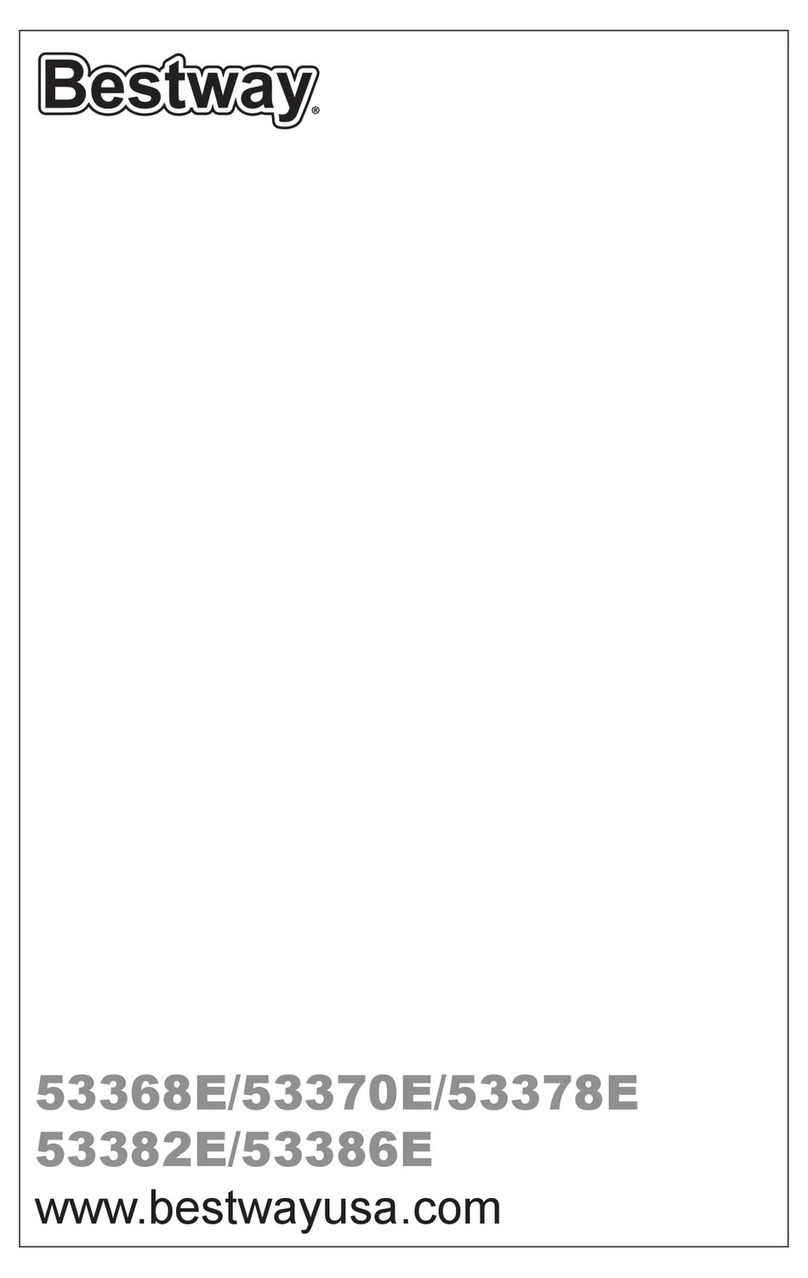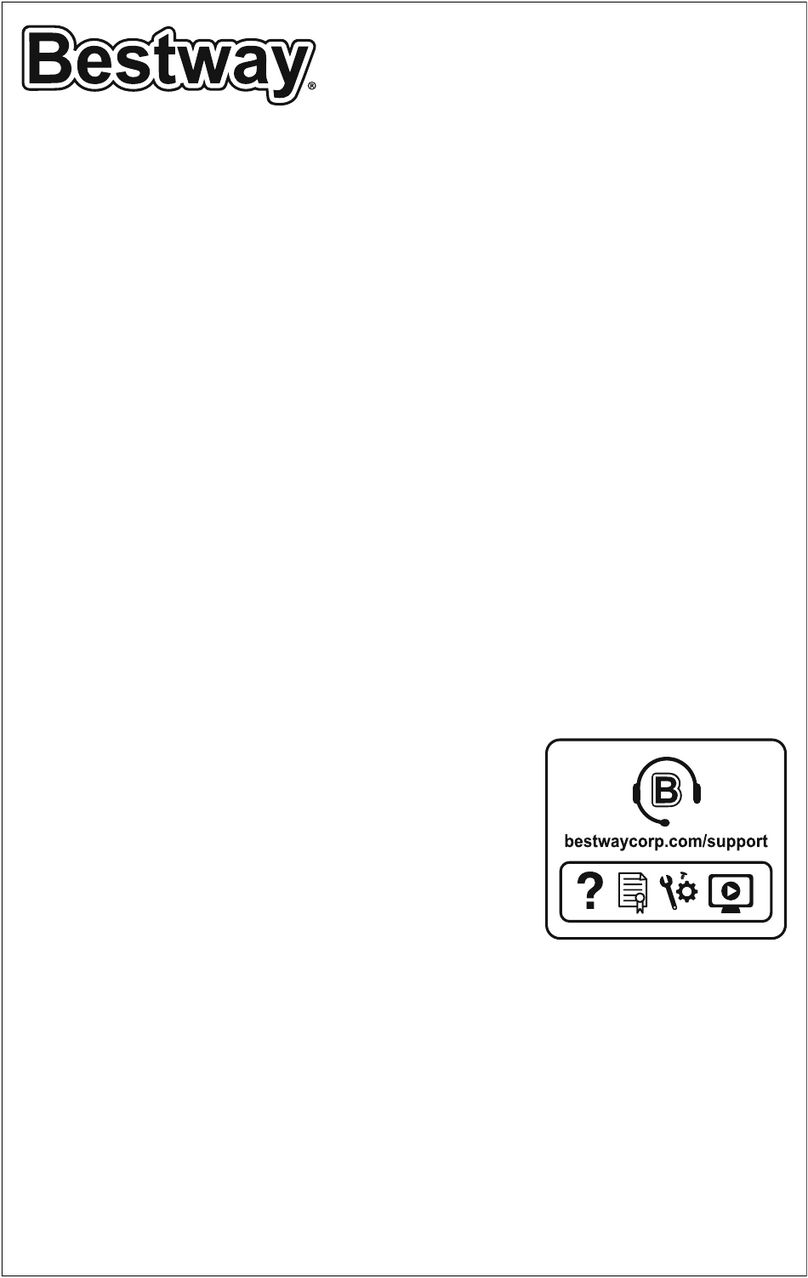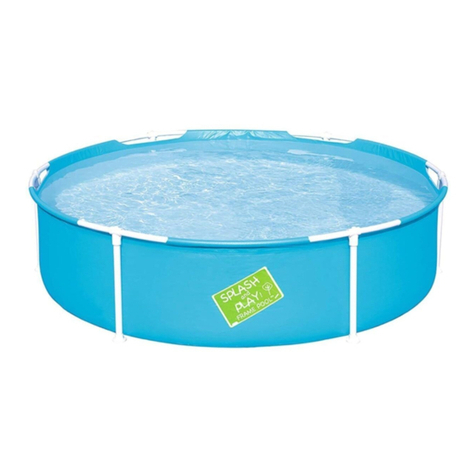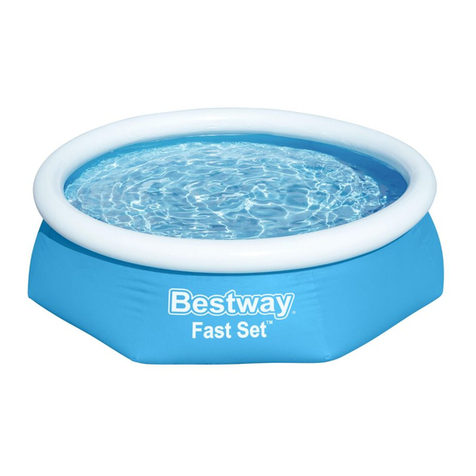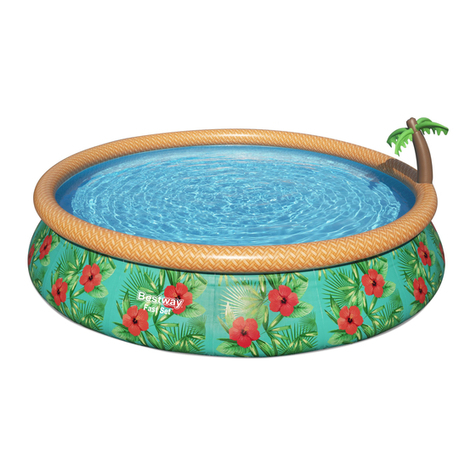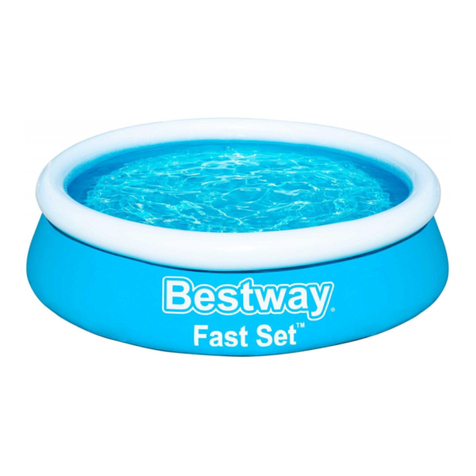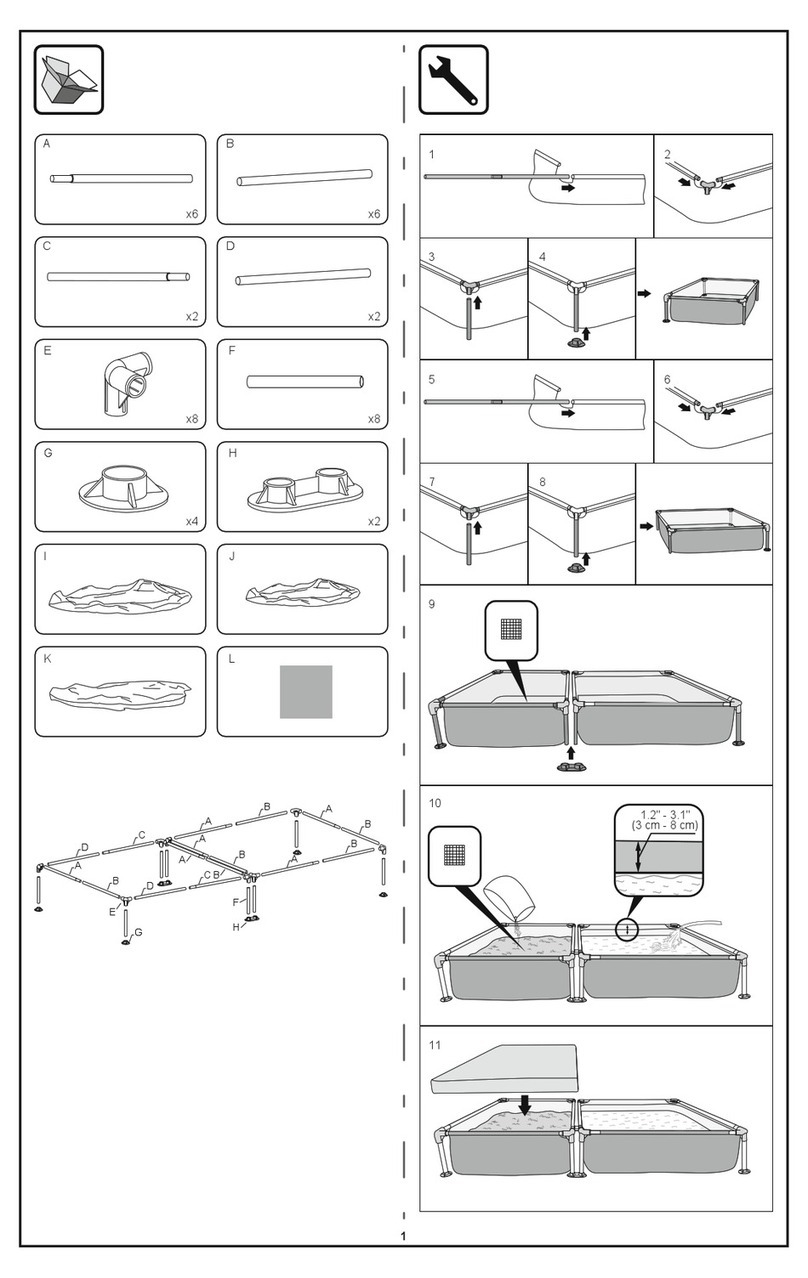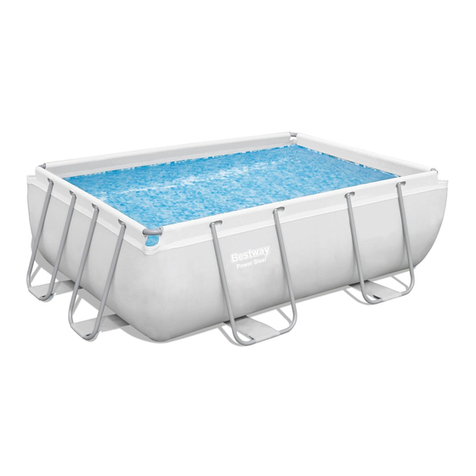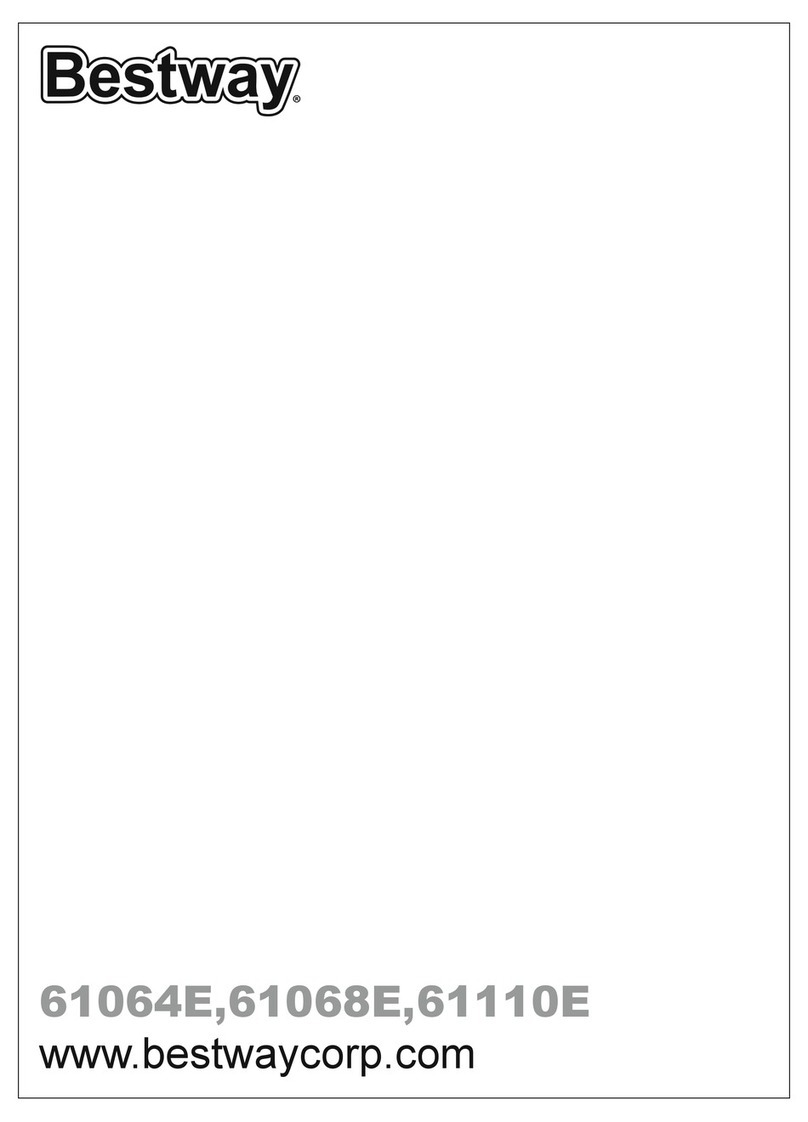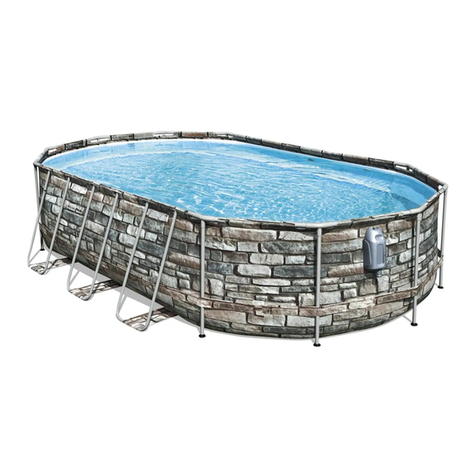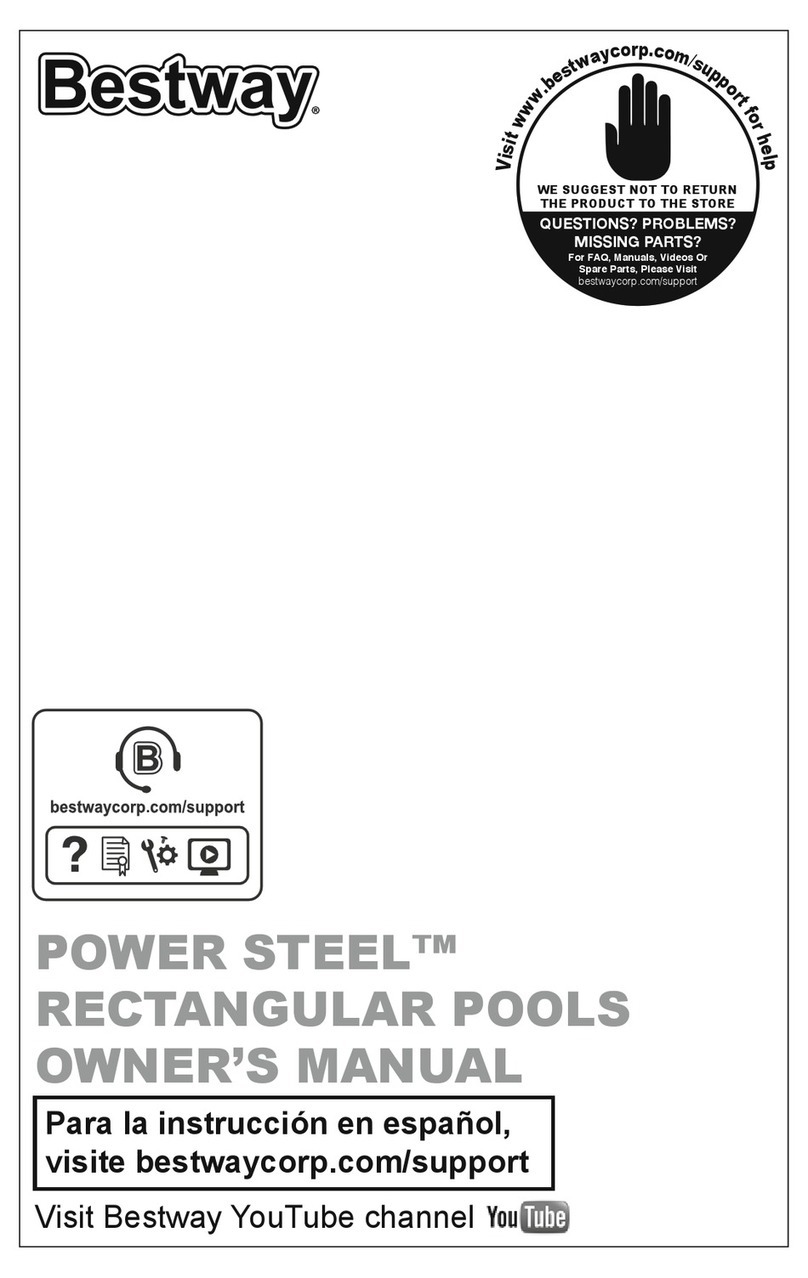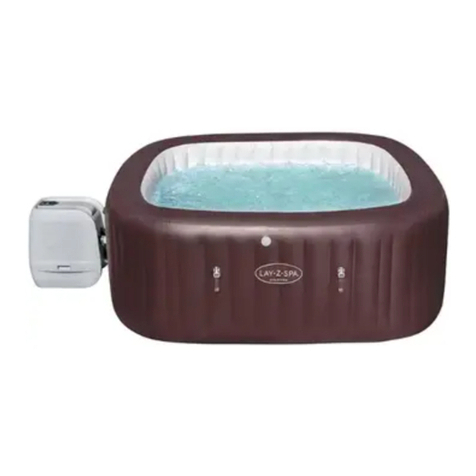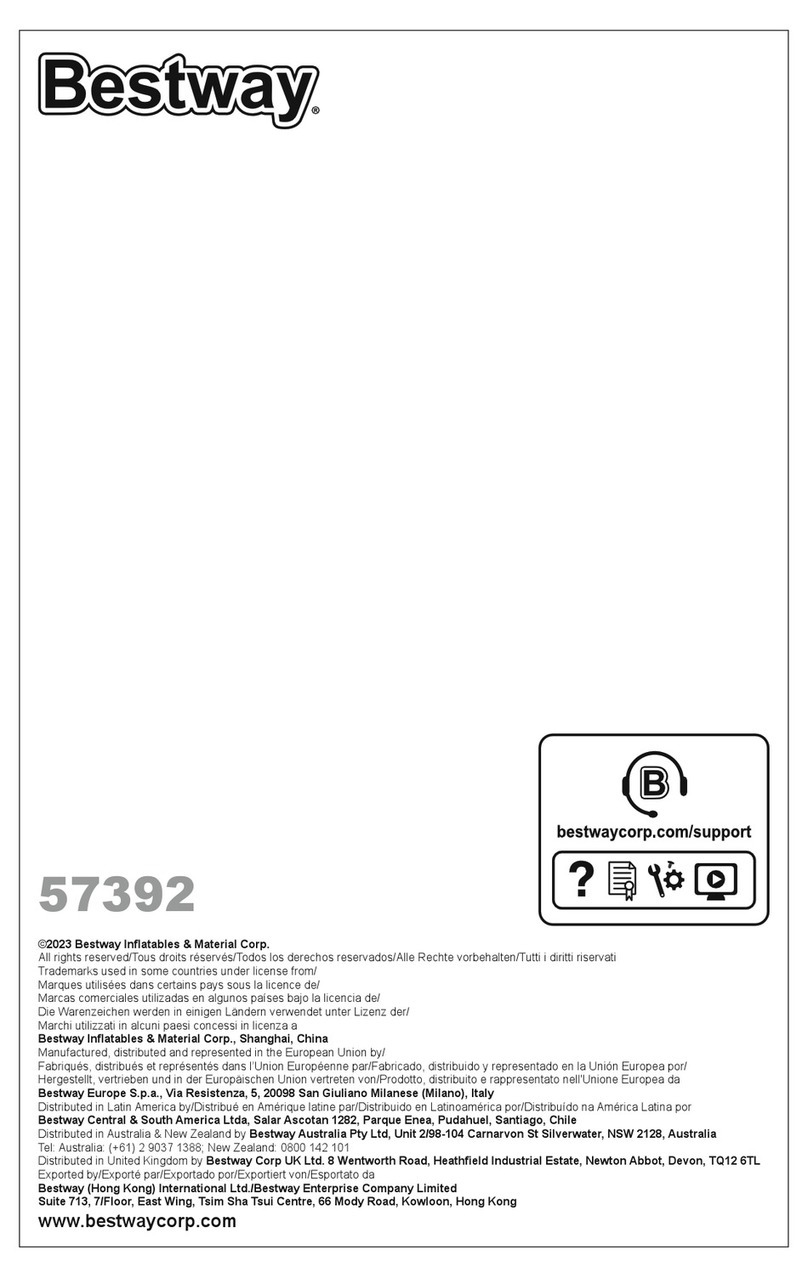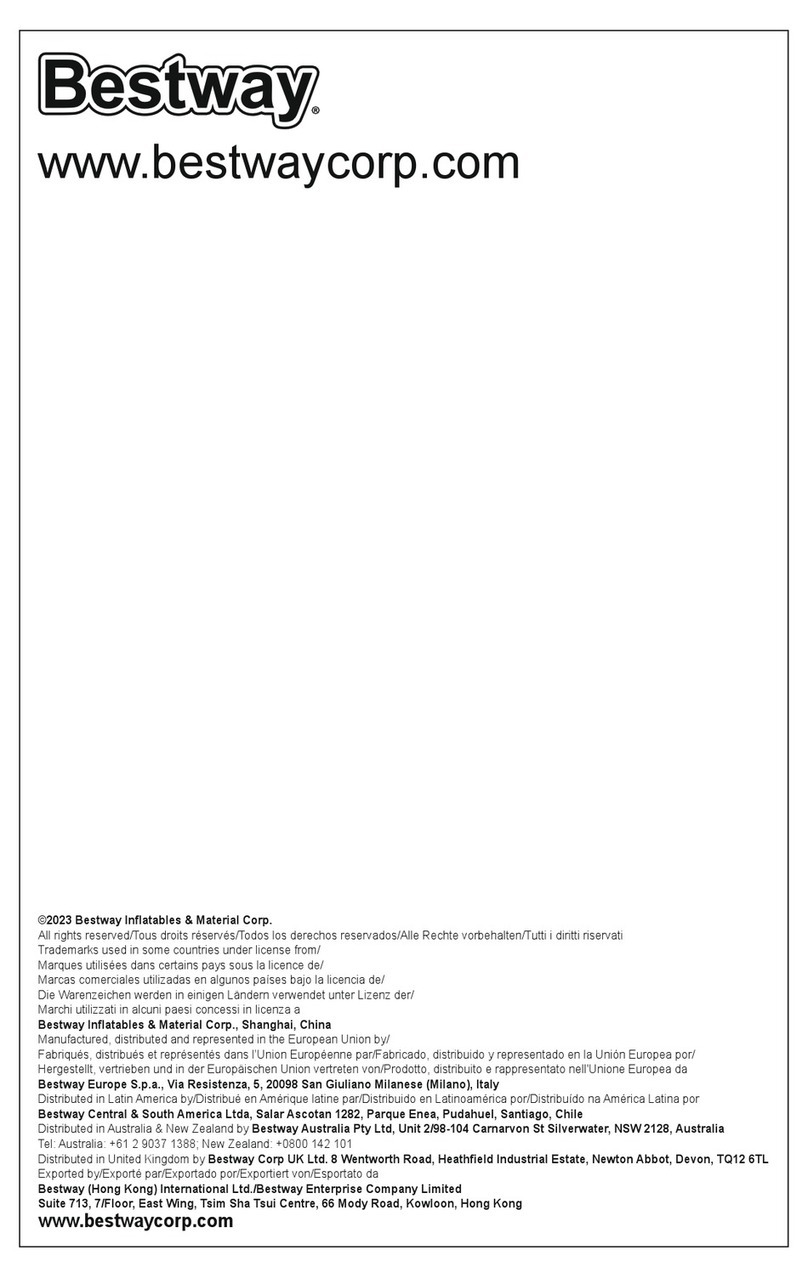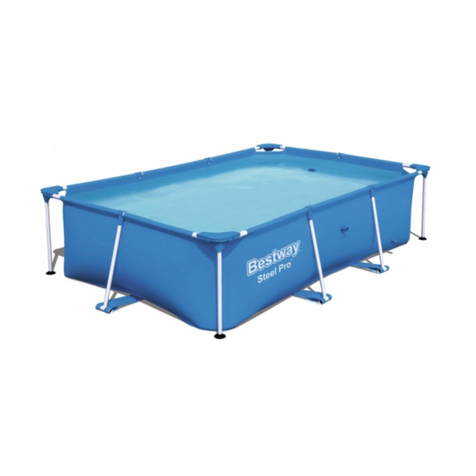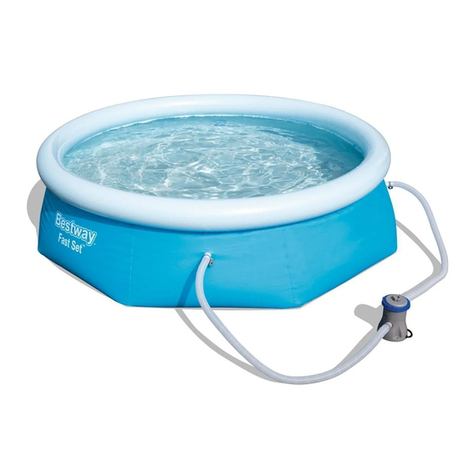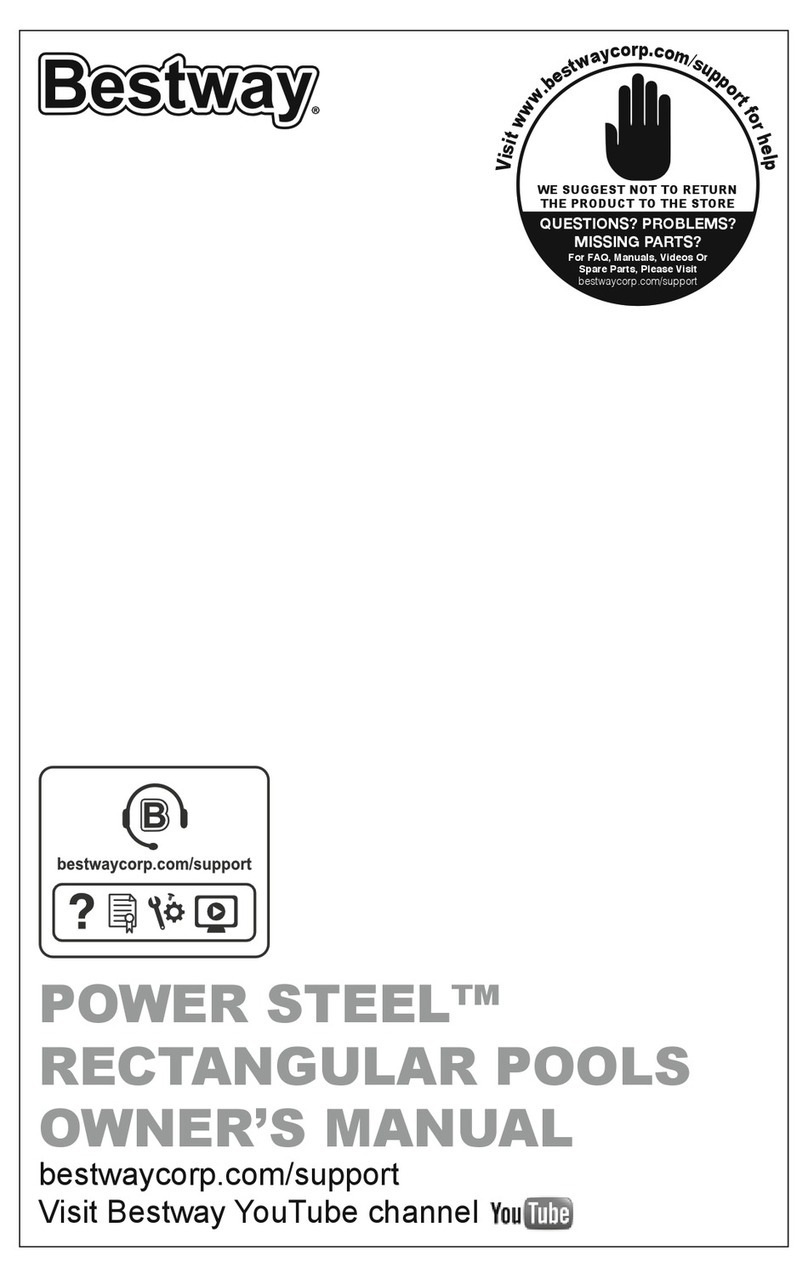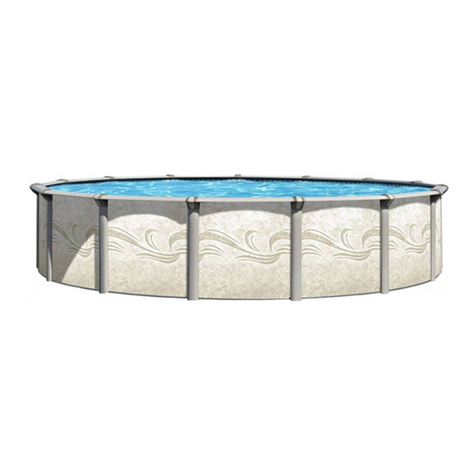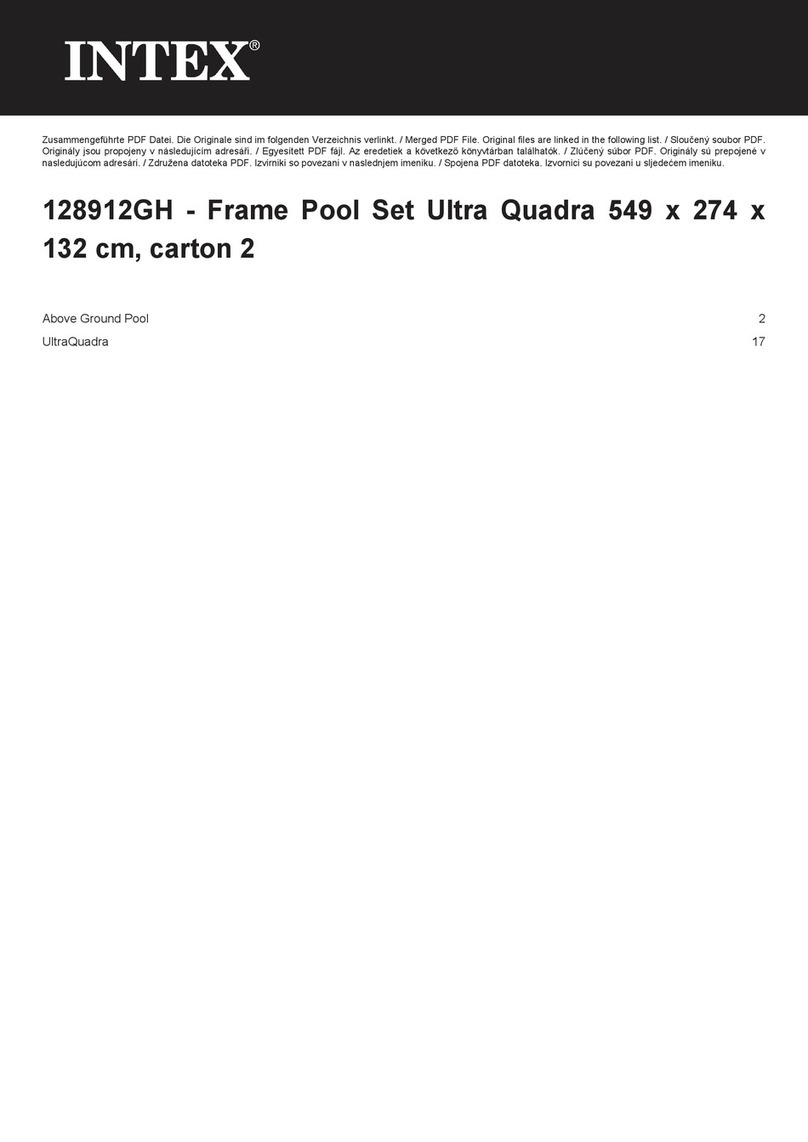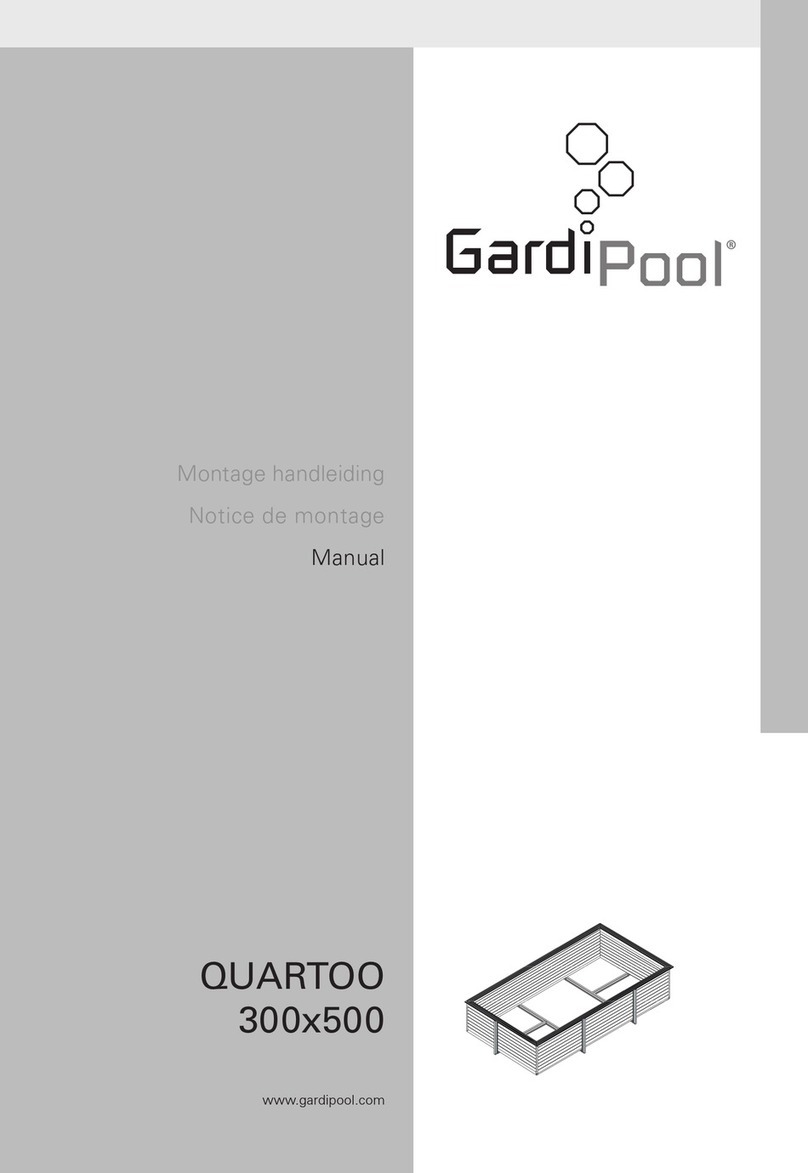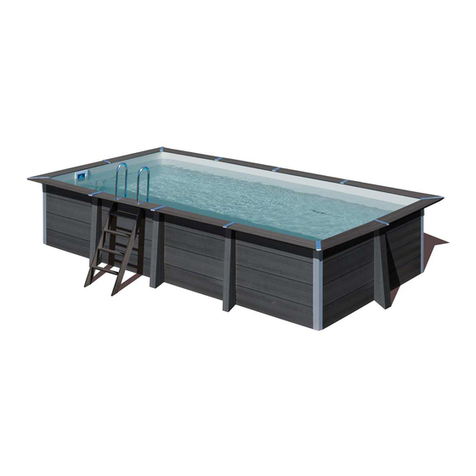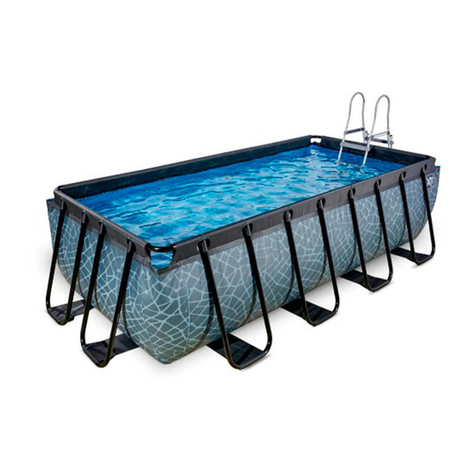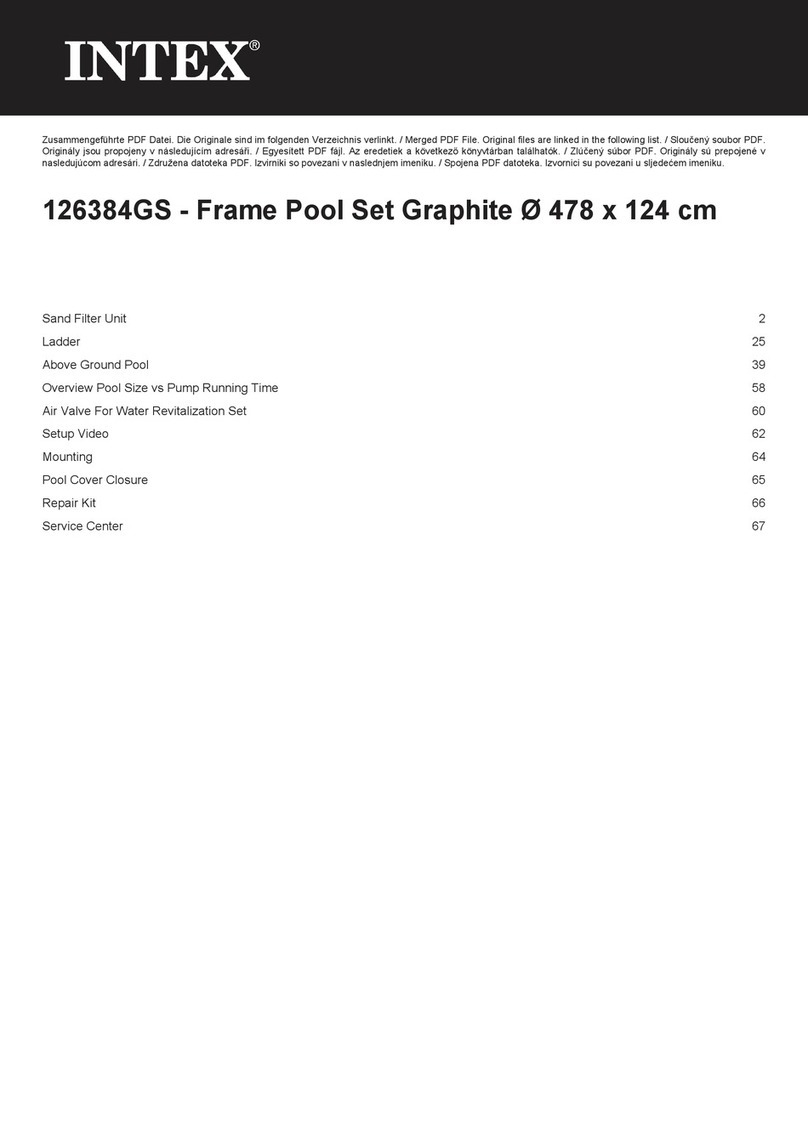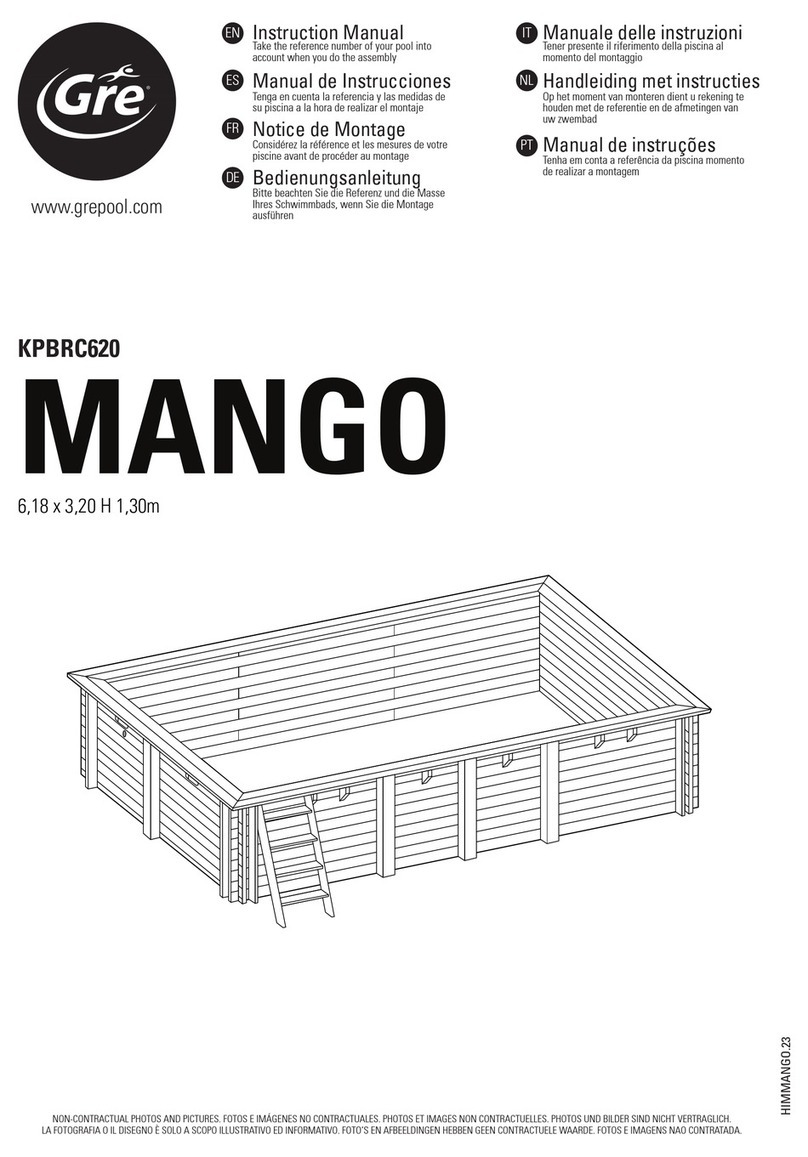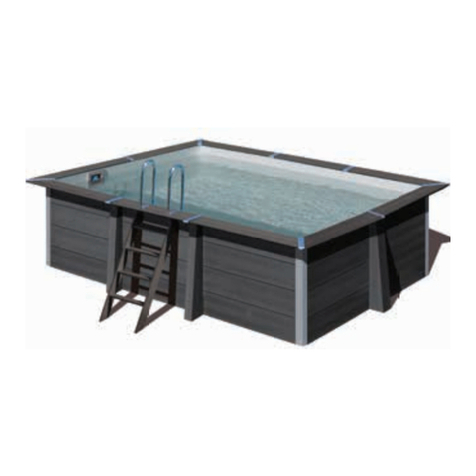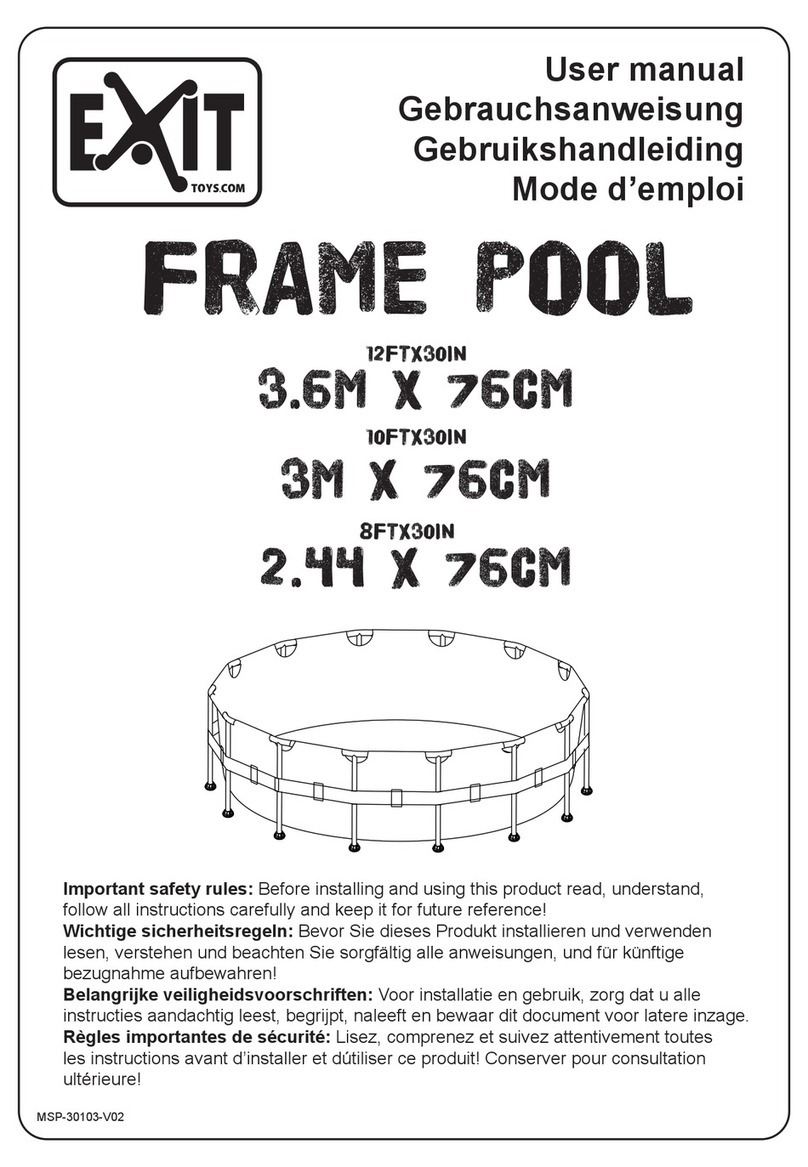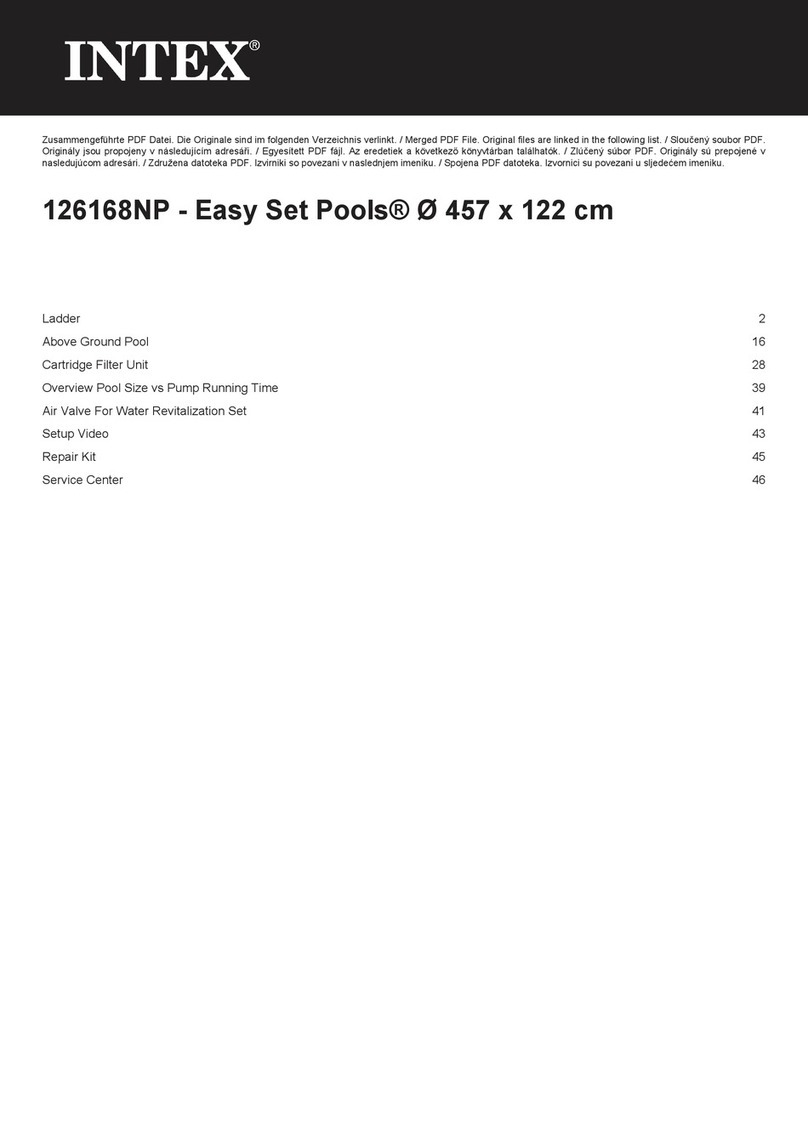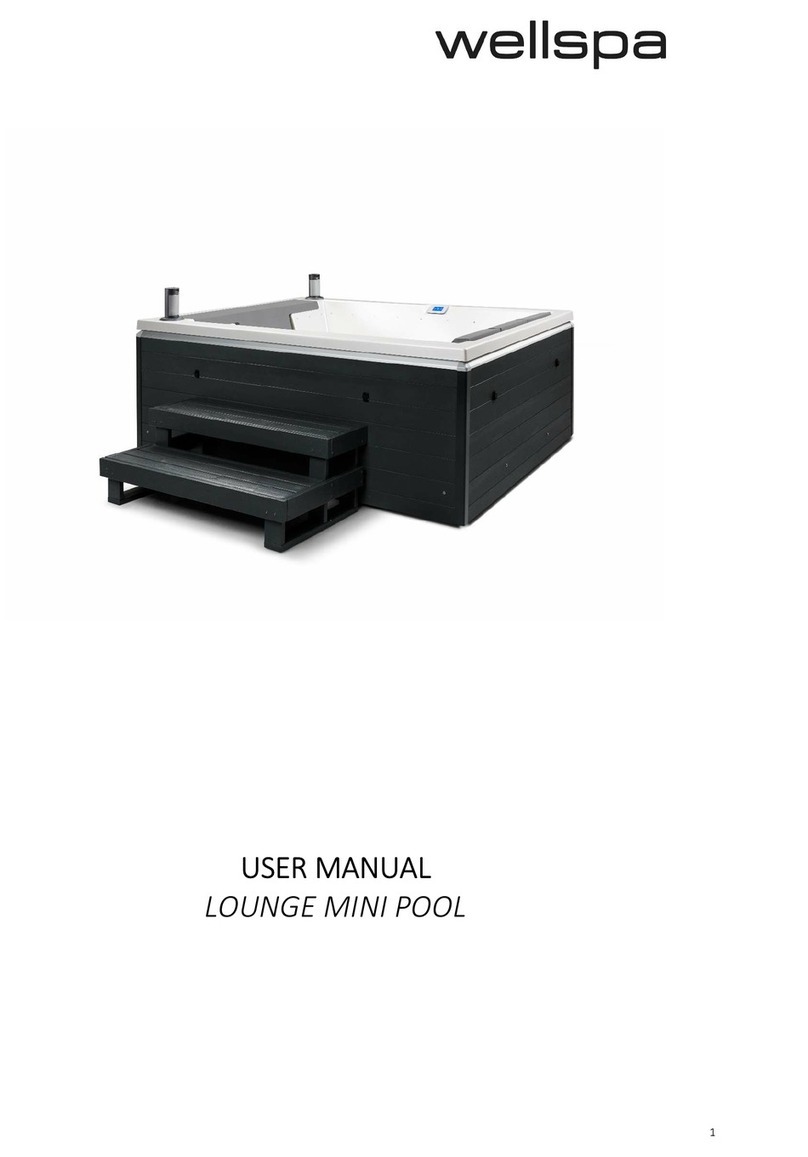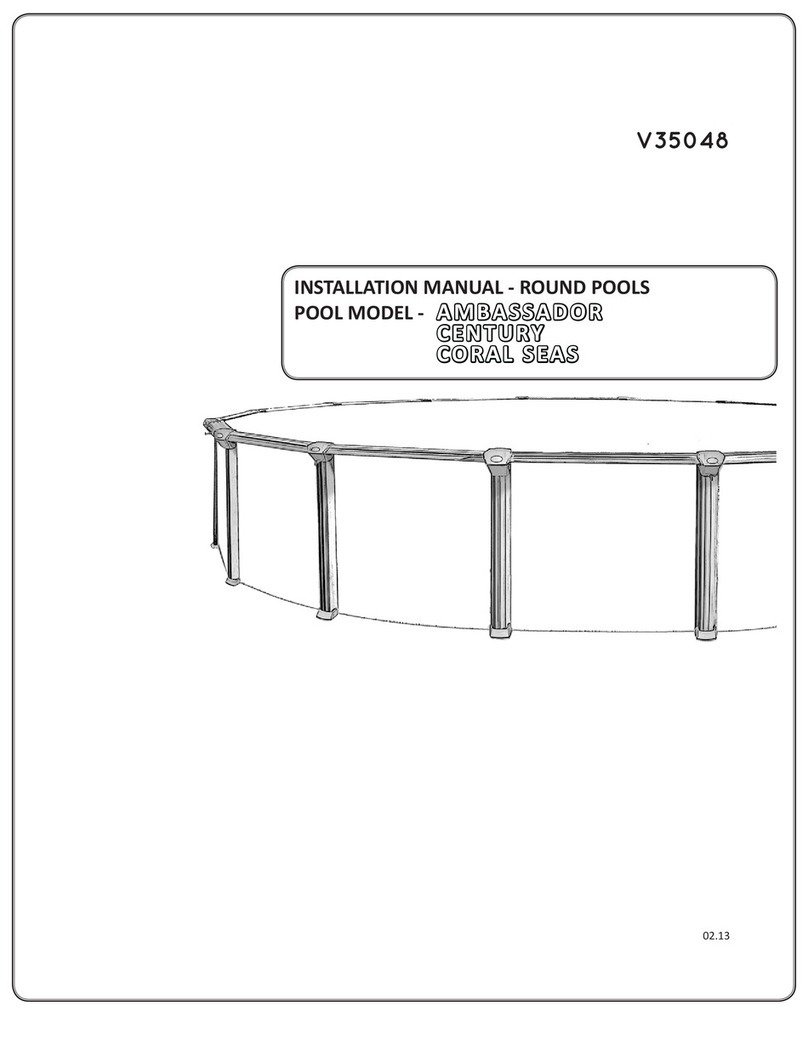
6
NOTE: Chemconnect or Chemical Floater must be used when you perform chemical maintenance with tablets. Your purchased item may
not include any of those dispensers, in this case you can purchase it by visiting our website www.bestwaycorp.com or at the nearest pool dealer.
POOL MAINTENANCE
If you do not adhere to the maintenance guidelines below, your health might be at risk, especially that of your children.
Using chemical tablets (not included):
pressure rating of 85 dBA at 10 feet and the sound of the alarm
should be distinctive from other household sounds, such as smoke
alarms, telephones, and door bells. The alarm should automatically
reset under all conditions. The alarm should be equipped with
manual means, such as touchpads or switches, to temporarily
deactivate the alarm for a single opening of the door from either
direction. Such deactivation should last for no more than 15
seconds. The deactivation touchpads or switches should be located
at least 54 inches above the threshold of the door.
(b) The pool should be equipped with a power safety cover which
complies with ASTM F1346-91 listed below.
(c) Other means of protection, such as self-closing doors with
self-latching devices, are acceptable so long as the degree of
protection afforded is not less than the protection afforded by (a) or
(b) described above.
10. Where an aboveground pool structure is used as a barrier or where
the barrier is mounted on top of the pool structure, and the means
of access is a ladder or steps, then (a) the ladder to the pool or
steps should be capable of being secured, locked or removed to
prevent access, or (b) the ladder or steps should be surrounded by
a barrier which meets Section I, Paragraphs 1 through 9. When the
ladder or steps are secured, locked, or removed, any opening
created should not allow the passage of a 4-inch diameter sphere.
Section II: Barrier Locations
Barriers should be located so as to prohibit permanent structures,
equipment or similar objects from being used to climb the barriers.
Only for outdoor use.
Teach your children to swim.
Never dive, jump, or slide into the pool.
Adult supervision is always required.
Parents should learn CPR.
Never swim alone.
Keep all electrical radios, speakers and other appliances away from
the swimming pool.
When you touch the filter, pump, or electrical parts, be sure the ground
under your feet is “Bone Dry.”
All electrical outlets should have a GFCI and connections should be a
minimum of 5 feet (1.52 m) from the outside perimeter of the wall of
the pool. From 5–10 feet (1.52–3.05 m), there should be either a fixed
connection (outlet box) or twistlock connection with a GFCI.
Connect power cords to a 3-wire grounding-type outlet only.
Keep all breakable objects out of the pool area.
Alcohol consumption and pool activities do not mix. Never allow
anyone to swim, dive or slide under the influence of alcohol or drugs.
Severe electrical shock could result if you install your pump or filter on
a deck. The pump or filter could fall into the water, causing severe
shock or electrocution. Do not install on a deck or other surface at,
above, or slightly below the top rail of the pool.
Do not use the pool during severe weather conditions, i.e. electrical
storms, tornadoes, etc.
Be aware of overhead power lines when vacuuming your pool or using
a telescoping pole.
Do not allow diving, climbing, sitting, or standing on the top rails of the
pools.
Do not allow roughhousing and horseplay.
Do not engage in extended breath holding activities underwater; you
may black out and drown.
Install a pool ladder(s) or staircase for entry and exit from the pool.
Keep deck clean and clear of objects that may create a tripping
hazard.
Check regularly for signs of wear or loose bolts that could make the
deck unsafe.
Instruct pool users about the proper use of all pool ladder(s) and
staircases.
Face ladder going up or down.
IMPORTANT SAFETY INSTRUCTIONS
Read and Follow All Safety Information and
Instructions.
Keep for future reference.
Failure to follow these warnings and instructions
can result in serious injury or death to users,
especially children.
Prevent Young Children From Drowning:
Install fencing or approved barrier around all sides of pool.
State or local laws or codes may require fencing or other approved
barriers.
Check state or local laws and codes before setting up pool.
Drowning occurs silently and quickly. Assign an adult to supervise pool
and wear provided water watcher tag.
Keep children in your direct sight when they are in or near pool and
when you are filling and emptying pool.
When searching for a missing child, check pool first, even if you think
your child is in the house.
Pool presents a drowning hazard even during filling and draining of the
pool. Maintain constant supervision of children and do not remove any
safety barriers until the pool is completely empty and stowed away.
Refer to the list of barrier recommendations and guidelines as
described in CPSC Publication No.362.
Assign an adult to be responsible for watching children in the pool.
Give this person a “water watcher” tag and ask that they wear it the
entire time they are in charge of supervising children in the pool. If they
need to leave for any reason, ask this person to pass the “water
watcher” tag and the supervision responsibility to another adult.
Locate pumps and filters in such a way that children cannot climb on
them to gain access to pool.
If you have a ladder, refer to the ladder's manual for instructions.
If you have a pump, refer to the pump's manual for instructions.
Prevent Young Children From Gaining Access to Pool:
Remove pool ladders before leaving pool. Toddlers can climb ladder
and get into pool.
Position furniture away from pool so that children cannot climb and
gain access to pool.
When leaving pool, remove floats and toys from pool that might attract
a child.
Be Prepared to Respond to an Emergency:
Keep a working phone and list of emergency numbers near pool.
Become certified in cardiopulmonary resuscitation (CPR) so you can
respond to an emergency.
Electrocution Risk:
Keep all electrical lines, radios, speakers, and other electrical devices
away from pool.
Do not place pool near or under overhead electrical lines.
Suction Risk:
Replacement pump should never exceed the maximum flow rate
marked on the suction fitting.
For further safety tips check out the following websites:
www.homesafetycouncil.org
http://www.safety-council.org/info/child/water.html
www.safekids.org
www.nspi.org
Safety Barrier Guidelines for Residential Swimming Pool
Section I: Outdoor swimming pool
An outdoor swimming pool, including an inground, aboveground, or
onground pool, hot tub, or spa, should be provided with a barrier which
complies with the following:
1. The top of the barrier should be at least 48 inches above grade
measured on the side of the barrier which faces away from the
swimming pool. The maximum vertical clearance between grade
and the bottom of the barrier should be 4 inches measured on the
side of the barrier which faces away from the swimming pool.
Where the top of the pool structure is above grade, such as an
aboveground pool, the barrier may be at ground level, such as the
pool structure, or mounted on top of the pool structure. Where the
barrier is mounted on top of the pool structure, the maximum
vertical clearance between the top of the pool structure and the
bottom of the barrier should be 4 inches.
2. Openings in the barrier should not allow passage of a 4-inch
diameter sphere.
3. Solid barriers, which do not have openings, such as a masonry or
stone wall, should not contain indentations or protrusions except for
normal construction tolerances and tooled masonry joints.
4. Where the barrier is composed of horizontal and vertical members
and the distance between the tops of the horizontal members is
less than 45 inches, the horizontal members should be located on
the swimming pool side of the fence. Spacing between vertical
members should not exceed 1-3/4 inches in width. Where there are
decorative cutouts, spacing within the cutouts should not exceed
1-3/4 inches in width.
5. Where the barrier is composed of horizontal and vertical members
and the distance between the tops of the horizontal members is 45
inches or more, spacing between vertical members should not
exceed 4 inches. Where there are decorative cutouts, spacing
within the cutouts should not exceed 1-3/4 inches in width.
6. Maximum mesh size for chain link fences should not exceed 1-3/4
inch square unless the fence is provided with slats fastened at the
top or the bottom which reduce the openings to no more than 1-3/4
inches.
7. Where the barrier is composed of diagonal members, such as a
lattice fence, the maximum opening formed by the diagonal
members should be no more than 1-3/4 inches.
8. Access gates to the pool should comply with Section I, Paragraphs
1 through 7, and should be equipped to accommodate a locking
device. Pedestrian access gates should open outward, away from
the pool, and should be self-closing and have a self-latching device.
Gates other than pedestrian access gates should have a
self-latching device. Where the release mechanism of the
self-latching device is located less than 54 inches from the bottom
of the gate, (a) the release mechanism should be located on the
pool side of the gate at least 3 inches below the top of the gate and
(b) the gate and barrier should have no opening greater than 1/2
inch within 18 inches of the release mechanism.
9. Where a wall of a dwelling serves as part of the barrier, one of the
following should apply:
(a) All doors with direct access to the pool through that wall should
be equipped with an alarm which produces an audible warning
when the door and its screen, if present, are opened. The alarm
should sound continuously for a minimum of 30 seconds within 7
seconds after the door is opened. Alarms should meet the
requirements of UL2017 General-Purpose Signaling Devices and
Systems, Section 77. The alarm should have a minimum sound
Allow only one person at a time on the ladder.
Check all nuts and bolts regularly to ensure that the ladder stays
sturdy.
Remove or secure the ladder to prevent entry to pool when not in use.
Please contact pool site dealer or manufacturer for additional safety
signs if deemed necessary.
For pool service, select a certified pool professional.
Any equipment connected to the circulation systems shall be
positioned so as to prevent their being used as a means of access to
the pool by young children.
The installation must comply with the codes of the authority having
jurisdiction and may require permits for building, plumbing electrical,
zoning, etc.
The pool shall be located a minimum distance of 6 ft. (1.83 m) from
any electrical receptacle.
All 125 volt, 15 and 20 ampere receptacles located within 20 ft. (6.0 m)
of the pool shall be protected by a ground fault circuit interrupter
(GFCI). The 20 ft. (6 m) distance is measured via the shortest straight
line distance the supply cord would follow without piercing a floor, wall,
ceiling, doorway, window, or other permanent barrier.
Prior to use of the pool, the installer shall affix all no diving signs and
safety signs in accordance with installation instructions so they can be
easily visible.
A barrier is necessary to provide protection against potential drowning
and near drowning and that barriers are not a substitute for the
constant supervision of children.
A list of emergency telephone numbers shall be posted, such as the
nearest available police, fire, ambulance, and/or rescue unit. These
numbers are to be kept near the telephone that is closest to the pool.
Toys, chairs, tables, or similar objects that a young child could climb
shall be at least 4 feet (1219 mm) from the pool.
If deck is used by the installer, it will need to comply with APSP-8.
Basic lifesaving equipment, including one of the following, shall be on
hand at all times: a. A light, strong, rigid pole (shepherd’s crook) not
less than 12 ft. (3.66 m) long. b. A minimum ¼ in. (6 mm) diameter
rope as long as 1½ times the maximum width of the pool or 50 feet
(15.24 m), whichever is less, which has been firmly attached to a
Coast Guard-approved ring buoy, or a similarly approved flotation
devices.
The swimming pool cover is not designated as a safety barrier.
Please use artificial lighting during nighttime pool use, to illuminate all
safety signs, ladders, steps, deck surfaces and walks.
The pool is subject to wear and deterioration. If not maintained
properly, certain types of excessive or accelerated deterioration can
lead to failure of the pool structure that might release large quantities
of water that could cause bodily harm and property damage.
The bottom of the pool shall be visible at all times from the outside
perimeter of the pool.
The installer of the vinyl liner shall affix on the original or replacement
liner, or on the pool structure, all safety signs in accordance with the
manufacturer’s instructions.
If you have a filter pump, refer to the pump’s manual for instructions.
The ladder shall be located on a solid base and the ladder shall be
installed per the ladder’s instructions.
Publications are available that describe the risk of drowning,
entrapment, and diving accidents. Available publications related to pool
safety include the Association of Pool and Spa Professionals’ (APSP)
booklets entitled: The Sensible Way to Enjoy Your
Aboveground/Onground Swimming Pool, Children Aren’t Waterproof,
Pool and Spa Emergency Procedures for Infants and Children, Layers
of Protection, and the latest published edition of ANSI/APSP-8 Model
Barrier Code for Residential Swimming Pools, Spas, and Hot Tubs.
For additional safety information, see www.APSP.org.
THIS PRODUCT IS COMPLIANT TO ANSI/ APSP 4 AMERICAN
NATIONAL STANDARD FOR ABOVEGROUND POOLS /
ONGROUND RESIDENTIAL SWIMMING POOLS & INTERNATIONAL
SWIMMING POOL & SPA CODE (ISPSC)
(Only for USA & only for pools with a water depth of more than
36in.(914mm))
NOTE: If your purchased pool set do not have any circulation
system, you can purchase separately. But please make sure the
equipment can turn over total volume of pool water no less than once
every 12 hr. You can check the water capacity on packaging to select
suitable circulation system. Pump provided for the circulation of water
shall be tested by a Nationally Recognized Testing Laboratory and
certified to conform to UL1081.
Also make sure the selected suction outlet sold with the pump should
be tested by a Nationally Recognized Testing Laboratory and certified
to conform to ASME/ANSI A112.19.8 or its successor standard ANSI/
APSP-16, in order to prevent suction entrapment.
Please read carefully and keep for future reference
CHOOSE THE CORRECT
LOCATION
The surface chosen to install the pool must respect the following
technical characteristics:
1. Because of the combined weight of the water inside the pool
and the pool users, it is extremely important that the surface
chosen to install the pool is capable of uniformly supporting the
total weight for the entire time the pool is installed. When choosing
the surface, take into consideration that water may come out of the
pool when in use or in the rain. If the water softens the surface, it
may lose its capability to support the pool weight.
2. Check regularly the position of the vertical legs and the
U-supports. They must be on the same level as the bottom of the
pool at all times. If the vertical leg or the U-support starts to sink
into the ground, drain the water immediately to avoid the pool
collapsing due to the uneven loading on the frame structure.
Change the location of the pool or modify the surface material.
3. We recommend positioning the pool away from any objects
children could use to climb into the pool.
4. Position the pool near an adequate drainage system to deal
with overflow or to discharge the pool.
5. The surface must be flat and smooth. If the surface is
inclined or uneven, it can create an unbalanced loading on the
structure of the pool. This situation can damage the welding point
of the liner and bend the frame. In the worst cases, the pool can
collapse, causing serious personal injury and/or damage to
personal property.
6. The selected surface must be clear of any type of object.
Due to the weight of the water, any object under the pool could
damage or perforate the bottom of the pool.
7. The selected surface must be clear of aggressive plants and
weed species. Those types of strong vegetation could grow
through the liner and create water leakage. The grass or other
vegetation that may cause odor or slime to develop have to be
eliminated from the set-up location.
8. The selected location must not have overhead power lines or
trees. Be sure the location does not contain underground utility
pipes, lines or cables of any kind.
9. The selected position must be far from house entrance. Do
not position any equipment or other furniture around the pool. The
water that comes out of the pool during the use or due to a faulty
product can damage the furniture inside the house or surrounding
the pool.
10. The selected surface must be flat and without holes that can
damage the material of the liner.
Follow the important instructions above to choose the correct surface
and location to set up your pool. Damaged parts of the pool, due to the
fact that the set-up surface and location does not match the
instructions, will not be considered as manufacture defect.
Suggested set-up surfaces: grass, ground, concrete, and all other
surfaces that respect the above set-up conditions.
Not suggested surfaces: mud, sand, gravel, deck, balcony, driveway,
platform, soft/loose soil or other surface that does not meet the above
set-up conditions.
NOTE: Check with your local city council for by-laws relating to
fencing, barriers, lighting and safety requirements and ensure you
comply with all laws.
NOTE: If have a filter pump, refer to the pump’s manual for
instructions.
NOTE: The ladder must match the pool size and should be
used only for entering and exiting the pool. It is forbidden to exceed the
permitted payload of the ladder. Check regularly if the ladder is
properly assembled.
FILLING POOL WITH WATER
ATTENTION:Do not leave pool unattended while filling
with water.
1. Fill the pool until the water reaches the welding line located
2.0in-7.9in (5cm-20cm) from the top of the pool. DO NOT
OVERFILL as this could cause the pool to collapse. In times of
heavy rainfall you may need to empty some of the water to ensure
the level is correct.
2. When filling the pool is completed, check that the water is not
collecting on any side to ensure the pool is level.
IMPORTANT: If pool is not level, drain water and
re-level ground by digging out. Never attempt to move the pool with
water in it, serious personal injury or damage to the pool may result.
WARNING: Your pool may contain a great deal of
pressure. If your pool has any bulge or uneven side then the pool is
not level, the sides may burst and the water may discharge
suddenly causing serious personal injury and/or damage to
property.
3. Check pool for any leaks at valves or seams, check any evident
water loss. Do not add chemicals until this has been done.
3. Turn the pool so the drain valve is near the area where your plan to
drain the water.
ATTENTION: Do not drag the pool on the ground in
order to avoid puncturing from sharp objects.
4. Insert the stopper plug into the inlet and outlet on the wall of the
pool from the inside of the pool. (See Fig. 8)
5. Insert top rail (A) into the pole pockets at the top of the pool.
(See Fig. 1)
6. Connect top rail (A) with T-Connector (C) at each of corner and
insert pins (D) into pre-drilled holes of the frame. (See Fig. 2, 3)
7. Repeat steps 5 and 6 until all top rails (A) are connected with all
T-Connectors (C) and the top frame is set up.
NOTE: For ease of assembly slightly raise the last 2 rails to
an inverted v shape and insert into the last T-Connectors(C). Slowly
lower until fully connected taking care not to pinch your fingers.
(See Fig. 4)
8. Connect vertical pool leg (B) into the bottom of the T-Connector (C).
(See Fig. 5)
NOTE: Make sure the hole on the vertical pool leg (B) is
facing outward.
9. Attach all footings (E) to the bottom of the vertical pool legs (B).
(See Fig. 6)
10. When the pool is completely assembled pull the frame from
different directions to ensure all rails, pool legs and connectors are
firmly jointed. (See Fig. 7)
11. Ensure drain valve is firmly closed. Smooth out the bottom.
12. Insert the 8 Tent legs (K) to the 8 T-Connectors (C) (See Fig. 9)
13. One fiberglass pole (L) has 3 sections. Extend the fiberglass pole
by pulling out each section and place it into the metal ferrules.
14. Insert one end of the pre-extend fiberglass pole to the Tent leg (K),
the other end to the Sprayer (F). Repeat this step for the other
fiberglass poles. Make sure the 8 fiberglass poles form a
semidome. (See Fig. 10)
15. Spread the tent’s outer cloth (O), make sure the center is above on
the Sprayer (F), adjust the tent’s outer cloth (O) position until the
sewing lines are superposed to the fiberglass poles (L). Hook the
tent’s outer cloth (O) to the hole of the vertical pool leg (B).
(See Fig. 11)
16. Tie the outer cloth (O) to the fiberglass pole (L) by using the 3 pairs
ropes at the inner of outer cloth (O). The rope can also fix the hose
(M).
17. Smooth out all wrinkles on the outer cloth and make it perfect.
IMPORTANT: Put 1in. to 2in. water in the pool to
cover the floor. Once pool floor is slightly covered, gently smooth
out all wrinkles. Start in the center of the pool and work your way
clockwise to the outside.
NOTE: Drawings for illustration purpose only. May not reflect
actual product. Not to scale.
INSTALLATION
Installation usually takes approximately 20 minutes with 2-3 people
excluding earthworks and filling.
Assembly the Splash-in-Shade play pool no need any tools. Bestway
will not be responsible for damage caused to the pool due to
mishandling or failure to follow these instructions.
1. Lay out all parts and check that you have the correct quantities as
listed in the components list. For assistance or FAQs, please visit
the support section on our website, www.bestwaycorp.com.
2. Spread out the pool and make sure the pool is right side up, let it
sit exposed to direct sunlight for 1 hour or more so that the pool is
more flexible during set up.
2.0in-7.9in
(5cm-20cm)
0°
Fig. 3 Fig. 4
Fig. 1 Fig. 2
Fig. 5 Fig. 6
Fig. 8
Fig. 7
Fig. 11
Fig. 9 Fig. 10

